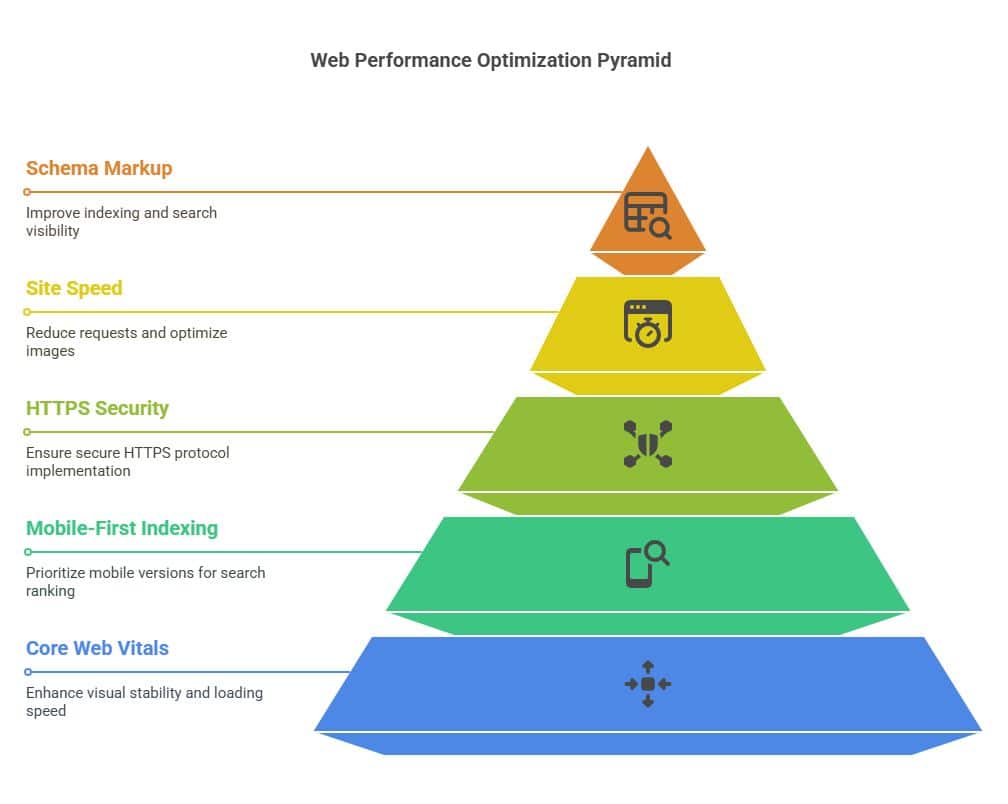
In 2023, mastering technical SEO is essential for enhancing website visibility and performance. Start by optimizing Core Web Vitals focusing on loading speed, visual stability, and interactivity. Adopt mobile-first indexing with responsive design and fast loading times. Secure your site with HTTPS to build trust and security. Boost site speed by optimizing images and employing caching strategies. Implement schema markup to enhance search visibility. Ensure an effective internal linking structure and keep XML sitemaps updated. Resolve duplicate content with canonical tags and conduct log file analysis for insights into server performance and crawl errors. Explore these technical SEO fundamentals checklist 2023 to refine your technical SEO approach further.
Key Takeaways
- Improve the visual stability, interactivity, and loading speed of Core Web Vitals.
- Use mobile-first indexing to enhance the mobile experience and give priority to mobile versions for ranking.
- To improve security and raise search engine rankings, make sure the HTTPS protocol is secure.
- Reduce HTTP requests, use caching techniques, and optimize images to increase site speed.
- Make use of schema markup to increase indexing efficiency and search visibility.

Tip 1. Optimize for Core Web Vitals
In the realm of technical SEO, optimizing for Core Web Vitals is essential for enhancing user experience and improving search engine rankings. Core Web Vitals are a set of specific factors that Google considers critical in a webpage’s overall user experience, focusing on three primary aspects: loading performance, interactivity, and visual stability. These metrics directly impact page performance and are paramount in determining how users interact with a site.
A critical component of user engagement is ensuring that websites load swiftly and are easy to navigate. This can be achieved by optimizing Largest Contentful Paint (LCP), which measures loading performance, ensuring that the main content of a page loads quickly and efficiently. Another vital factor is First Input Delay (FID), which evaluates a page’s interactivity. A low FID ensures that users can interact with the page without frustrating delays. Lastly, Cumulative Layout Shift (CLS) gauges visual stability, ensuring that the elements on a page do not move unexpectedly, providing a seamless browsing experience.
Mobile optimization and website accessibility are crucial in aligning with Core Web Vitals. As more users access websites via mobile devices, ensuring that sites are responsive and perform well on smaller screens is non-negotiable. This includes optimizing images and employing efficient coding practices to enhance page speed and reliability. Furthermore, a focus on website accessibility ensures that all users, including those with disabilities, can access and interact with content efficiently, thereby broadening the reach and impact of a website. Prioritizing Core Web Vitals contributes significantly to a site’s overall success in the digital landscape.
Tip 2. Implement Mobile-First Indexing
As the digital landscape evolves, implementing mobile-first indexing has become a cornerstone of effective SEO strategy. With a growing number of users accessing the web via mobile devices, ensuring your website is mobile-friendly is no longer optional—it’s imperative. Mobile-first indexing means that Google primarily uses the mobile version of a website for indexing and ranking. This shift highlights the need for mobile usability, emphasizing the importance of having a responsive design that adapts seamlessly to various screen sizes and devices.
An optimized user experience on mobile devices not only enhances site accessibility but also plays a critical role in maintaining competitive search engine rankings. Mobile optimization involves several key practices, such as ensuring fast loading times, streamlined navigation, and readable content without the need for horizontal scrolling. Responsive design ensures that your site adjusts automatically to fit the user’s device, providing an optimal viewing experience.
To achieve effective mobile usability, regular testing and adjustments are necessary. Tools like Google’s Mobile-Friendly Test can help identify areas needing improvement. Prioritizing mobile optimization not only aligns with Google’s indexing practices but also caters to the expectations of modern users who demand fast, accessible, and engaging online interactions.
In essence, implementing mobile-first indexing is about more than just aligning with search engine guidelines; it’s about enhancing the overall user experience and ensuring that your site remains accessible and functional across all devices. This proactive approach to mobile usability will set the foundation for sustainable SEO success in an increasingly mobile-centric world.
Tip 3. Ensure Secure HTTPS Protocol

Security is paramount in the digital realm, making the adoption of HTTPS protocol an essential aspect of technical SEO. HTTPS, or Hyper Text Transfer Protocol Secure, ensures that data exchanged between the user’s browser and your server is encrypted and secure. This is achieved through SSL Certificates, which authenticate the identity of a website and encrypt the information sent to the server. In today’s digital age, where data breaches are common, the implementation of HTTPS significantly boosts user trust, as visitors are assured that their private data, such as credit card information and passwords, are protected from interception.
The transition from HTTP to HTTPS is not just about security; it also impacts search ranking. Major search engines, including Google, factor HTTPS into their ranking algorithms, meaning sites with SSL Certificates can experience enhanced visibility in search results. This is a critical consideration for businesses aiming to improve their online presence and drive more organic traffic to their websites.
Moreover, data encryption through HTTPS ensures browser security, which is vital for maintaining a positive user experience. Modern browsers, like Chrome and Firefox, alert users when they are about to enter a non-secure site. A “Not Secure” warning can deter visitors, impacting your site’s bounce rate and overall engagement metrics.
Tip 4. Improve Site Speed

A crucial element of technical SEO is site speed, which directly influences user experience and search engine rankings. Faster page loading times lead to improved user satisfaction and higher engagement levels, as visitors are less likely to abandon slow-loading websites. Search engines like Google prioritize fast sites, making speed optimization an essential aspect of SEO strategy.
To enhance site speed, consider focusing on the following key areas:
- Image Optimization: Large images can significantly slow down page loading times. Utilize compression techniques and modern formats like WebP to reduce file sizes without compromising quality. Implementing responsive images can further enhance performance on different devices.
- Server Response Time: A slow server can hinder site speed regardless of other optimizations. Choose a reliable hosting provider and consider leveraging a Content Delivery Network (CDN) to distribute content more efficiently. Regularly monitor server performance to ensure quick response times.
- Caching Strategies: Caching reduces the amount of data transferred and speeds up page loading by storing copies of web pages. Implement browser caching and server-side caching to enhance the delivery of repeat visits. Tools like Varnish or Redis can be integrated to further improve caching efficiency.
- Minimize HTTP Requests: Each element on a page, such as scripts and stylesheets, requires an HTTP request. Minimizing these requests by combining files, removing unnecessary elements, and utilizing asynchronous loading can significantly improve page speed.
Tip 5. Utilize Schema Markup

When it comes to boosting your website’s visibility in search engine results, leveraging schema markup can make a significant difference. Schema markup, a form of structured data, serves as a powerful tool that communicates with search engines to provide a deeper understanding of your site’s content. By implementing schema markup, you enhance your site’s search visibility, allowing it to stand out in an increasingly competitive digital landscape.
One of the primary schema benefits is the potential to generate rich snippets in search engine results. Rich snippets are enhanced listings that display additional information, such as ratings, reviews, or event details, directly in the search results. These snippets not only draw attention but also improve the click-through rate, as users are more likely to interact with listings that present more informative and engaging content at first glance.
Furthermore, structured data can significantly boost your SEO performance by helping search engines index your content more efficiently and accurately. This improved indexing can lead to better positioning in search results, providing a competitive advantage over sites that have yet to adopt schema markup. As search engines evolve to deliver more personalized and contextually relevant results, using schema markup becomes a critical component of a comprehensive SEO strategy.
Incorporating schema markup into your website’s code may seem daunting at first, but numerous tools and plugins are available to simplify the process. By taking the time to implement and optimize schema markup, you not only enhance your website’s search visibility but also ensure that your content is presented in the most compelling manner possible.
Tip 6. Manage Crawl Budget Effectively

As you enhance your site’s structure with schema markup, it’s equally important to manage your crawl budget effectively to optimize your website’s performance in search engine results. The crawl budget represents the number of pages search engine bots can and want to crawl on your site within a given timeframe. Efficient management of this budget ensures that crucial pages are indexed promptly, contributing to better search visibility.
To enhance crawl efficiency, consider these key strategies:
- Bot Management: Utilize robots.txt files to guide bots on which pages to crawl. By directing bots away from non-essential pages, such as admin or duplicate content, you improve the focus on high-priority pages, thus enhancing resource allocation.
- Resource Allocation: Analyze server logs to understand where crawl resources are being spent. This analysis helps in identifying unnecessary bot activity, allowing you to allocate resources more efficiently to important pages.
- Indexing Priority: Ensure that pages with high SEO value and traffic potential are prioritized. This can be achieved by refining your sitemap to highlight these key pages. Additionally, examining page depth is crucial, as pages buried deep within your site may be less likely to be crawled and indexed.
- Page Depth: Simplify your site’s architecture to reduce page depth, making essential content more accessible to search engine bots. A shallow site hierarchy not only aids in better indexing but also improves user navigation.
Tip 7. Internal Linking Structure

Establishing a robust internal linking structure is pivotal for enhancing your website’s SEO performance and user experience. Internal linking strategies not only facilitate seamless user navigation but also play a crucial role in distributing link equity throughout your site. By thoughtfully interconnecting your pages, you guide users and search engines alike, ensuring that important content is both accessible and prioritized.
An effective internal linking strategy begins with the selection of appropriate anchor text. Anchor text serves as a descriptive label, signaling to both users and search engines what the linked page is about. This enhances content relevance and helps search engines understand the context and importance of the linked page. By using descriptive, keyword-rich anchor text, you improve the likelihood that search engines will appropriately index and rank your pages.
Moreover, a well-structured internal linking framework supports user navigation by creating intuitive pathways through your content. This not only enhances the user experience but also encourages visitors to stay longer on your site, exploring related topics. In turn, this can lead to increased engagement and lower bounce rates, which are positive signals to search engines.
Furthermore, distributing link equity effectively reinforces the authority of your most important pages. By linking to high-value content from various parts of your site, you can concentrate link authority and bolster the SEO performance of essential pages. This balanced distribution ensures that no page is left isolated, enhancing the overall coherence and strength of your website.
Tip 8. Prioritize XML Sitemap Updates

Building on a solid internal linking structure, another fundamental aspect of technical SEO is the regular updating of your XML sitemap. The importance of a well-maintained XML sitemap cannot be overstated, as it acts as a roadmap for search engines, directing them to the most crucial pages of your website. To optimize your site’s performance, it’s essential to prioritize XML sitemap updates, ensuring search engines can efficiently crawl and index your content.
Here are four key considerations for managing your XML sitemap:
- Sitemap Importance: Recognize the XML sitemap as a critical tool that guides search engines through your site. It highlights priority pages, helping search engines understand the hierarchy and relevance of your content.
- Update Frequency: Regularly update your sitemap to reflect any changes in your website’s structure, such as new pages or removed content. Consistent updates ensure that search engines have the most accurate representation of your site, enhancing indexing benefits.
- Indexing Benefits: An up-to-date sitemap can significantly improve the indexing process. By ensuring search engines have access to your latest content, you increase the likelihood of your pages appearing in search results promptly.
- Error Handling: Regularly audit your sitemap for errors, such as broken links or outdated URLs, which can hinder your site’s SEO performance. Addressing these errors promptly ensures search engines continue to view your site favorably.
Prioritizing XML sitemap updates is essential for enhancing your site’s visibility and search engine performance. By focusing on these key aspects, you ensure your website remains accessible and authoritative in the ever-evolving digital landscape.
Tip 9. Resolve Duplicate Content Issues

Duplicate content can significantly undermine your site’s search engine performance, causing confusion for search algorithms and potentially leading to lower rankings. Understanding and resolving these issues is crucial for maintaining the integrity and visibility of your website. One effective tool to address duplicate content is the use of canonical tags. By implementing canonical tags, you can inform search engines about the preferred version of a webpage, ensuring that the correct page receives the credit for its content, thus preventing dilution of ranking signals.
Another common source of duplicate content is content syndication. While syndicating content can expand its reach, it is important to ensure that the original version is clearly identified as the primary source. This can be achieved by using canonical tags or specifying the source in the metadata, helping search engines discern the original content from its syndicated counterparts.
URL parameters can also lead to duplicate content, as different parameters might render similar content on multiple URLs. Regularly conducting content audits allows you to identify and address such issues, ensuring that each piece of content is only accessible through a single, optimized URL.
Moreover, employing plagiarism detection tools can help identify unauthorized duplication of your content by external sites. Protecting your original content from being duplicated by others not only preserves its value but also maintains your site’s authority.
Tip 10. Monitor and Analyze Log Files

Addressing duplicate content issues lays a strong foundation for improving your site’s SEO performance, but to further enhance visibility and efficiency, it’s important to focus on the technical aspects of your website, such as monitoring and analyzing log files. Log file analysis provides a wealth of data insights essential for understanding how search engines interact with your site. By examining server logs, you can gain a clearer picture of user behavior and search engine bots’ activities, leading to more informed optimization strategies.
Here are four key benefits of regular log file analysis:
- Identify Crawl Errors: Log files reveal instances where search engine bots encounter obstacles on your site. Analyzing these errors helps in diagnosing and resolving issues that might impede indexing, ensuring your content remains accessible.
- Understand User Behavior: By reviewing logs, you can track patterns in user visits, including peak traffic times and frequently accessed pages. This insight assists in optimizing server response during high-demand periods, enhancing user experience.
- Monitor Server Response: Log files provide data on server status codes, helping identify instances of slow or failed responses. Timely detection and resolution of these issues ensure your site remains responsive, reducing bounce rates.
- Gain SEO Data Insights: Continuous log file monitoring offers valuable insights into how search engines perceive your site. This information can guide strategic decisions regarding content updates, structural changes, and resource allocation.
Incorporating log file analysis into your SEO strategy is pivotal for maintaining a robust online presence. It empowers you with the knowledge necessary to refine your site’s technical performance, ultimately fostering better search engine rankings and user satisfaction.
Final Thoughts
Mastering technical SEO fundamentals in 2023 is critical for improving a website’s visibility, user experience, and performance. By focusing on optimizing Core Web Vitals, ensuring mobile-first indexing, securing HTTPS, and enhancing site speed, you’ll set a solid foundation for success. Implementing schema markup, managing crawl budgets effectively, and maintaining an organized internal linking structure further contribute to search engine optimization. Regularly updating XML sitemaps, addressing duplicate content, and conducting log file analysis are crucial steps in refining your technical SEO strategy. With these best practices, you can create a robust, search-friendly site that delivers excellent user experiences and long-term results.
Ready to take your website’s technical SEO to the next level? Contact Syville Gacutan, an experienced SEO Specialist in the Philippines. Syville can help you enhance your site’s performance, boost search visibility, and achieve sustainable online growth. Connect today for expert guidance and proven SEO solutions!